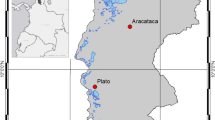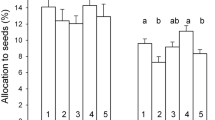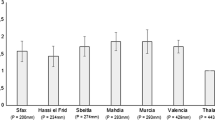Abstract
Polygonum aviculare is an annual weedy species showing extensive genetic variation in seed and leaf size and colonizing various types of man-disturbed habitats. A growth analysis was conducted on 12 genotypes representative of three regimes of disturbance of natural habitat (trampling, weeding, and no disturbance in the course of the growing season), grown under productive conditions in order to test whether relative growth rate (RGR) varies at the intraspecific level and, if so, which growth parameters may explain its variation. RGR showed significant genotypic variation (0.355–0.452 g g-1 day-1), positively correlated with specific leaf area (SLA) and leaf mass ratio (LMR) and negatively correlated with unit leaf rate per unit leaf area (ULRA). Thus, the paramount importance of leaf area ratio (LAR=SLA×LMR) in determining growth rate variation between different herbaceous species is confirmed at the intraspecific level in this species. Genotypes originating from trampled habitats had smaller seeds and smaller leaves than genotypes from habitats subject to other disturbance regimes. Additionally, they showed a lower LAR, not entirely compensated for by a higher ULRA, which resulted in a positive allometric relationship between seed size and RGR. It is hypothesized that their lower SLA, correlated with a higher leaf dry matter content (possibly a consequence of a higher cell wall content per unit leaf area) and their lower LMR have been co-selected with small leaf size as adaptations promoting resistance to trampling stress. It is suggested that variation in cell size and/or gibberellin content might be the mediators of the correlation found between seed size, leaf size and growth parameters within this species.
Similar content being viewed by others

References
Arendonk JJCM van, Poorter H (1994) The chemical composition and anatomical structure of leaves of grass species differing in relative growth rate. Plant Cell Environ 17:963–970
Burdon JJ, Harper JL (1980) Relative growth rates of individual members of a plant population. J Ecol 68:953–957
Chapin FS III, Groves RH, Evans LT (1989) Physiological determinants of growth rate in response to phosphorus supply in wild and cultivated Hordeum species. Oecologia 79:96–105
Choe HS, Chu C, Koch G, Gorham J, Mooney HA (1988) Seed weight and seed resources in relation to plant growth rate. Oecologia 76:158–159
Cook MG, Evans LT (1983) Some physiological aspects of the domestication and improvement of rice (Oryza spp). Field Crop Res 6:219–238
Dijkstra P, (1990) Cause and effect of differences in specific leaf area. In: Lambers H, Cambridge ML, Konings H, Pons TL (eds) Variation in growth rate and productivity. SPB Academic, The Hague, pp 125–140
Dijkstra P, Lambers H (1989a) A physiological analysis of genetic variation in relative growth rate within Plantago major L. Funct Ecol 3:577–587
Dijkstra P, Lambers H (1989b) Analysis of specific leaf area and photosynthesis of two inbred lines of Plantago major differing in relative growth rate. New Phytol 113:283–290
Dijkstra P, Ter Reegen HA, Kuiper PJC (1990) Relation between relative growth rate, endogenous gibberellins, and the response to applied gibberellic acid for Plantago major. Physiol Plant 79:629–634
Evans LT (1993) Crop evolution, adaptation and yield. Cambridge University Press, Cambridge
Garnier E (1991) Resource capture, biomass allocation and growth in herbaceous plants. Trends Ecol Evol 6:126–131
Garnier E (1992) Growth analysis of congeneric annual and perennial grass species. J Ecol 80:665–675
Garnier E, Laurent G (1994) Leaf anatomy, specific mass and water content in congeneric annual and perennial grass species New Phytol 128:725–736
Geber MA (1990) The cost of meristem limitation in Polygonum arenastrum: negative genetic correlations between fecundity and growth. Evolution 44:799–819
Geber MA, Dawson TE (1990) Genetic variation in and covariation between leaf gas exchange, morphology, and development in Polygonum arenastrum, an annual plant. Oecologia 85:153–158
Gotlieb LD (1978) Allocation, growth rates and gas exchange in seedlings of Stephanomeria exigua ssp coronaria and its recent derivative S. malheurensis. Am J Bot 65:970–977
Grime JP (1979) Plant strategies and vegetation processes. Wiley, Chichester
Grime JP, Hunt R (1975) Relative growth-rate: its range and adaptive significance in a local flora. J Ecol 63:393–422
Grime JP, Hodgson JG, Hunt R (1988) Comparative plant ecology. Allen and Unwin, London
Hunt R (1982) Plant growth curves. The functional approach to plant growth analysis. Edward Arnold, London
Hunt R, Parsons IT (1974) A computer program for deriving growth functions in plant growth analysis. J Appl Ecol 11:297–307
Kik C, Jongman M, Van Andel J (1991) Variation in relative growth rate and survival in ecologically contrasting populations of Agrostis stolonifera. Plant Sp Biol 6:47–54
Konings H (1990) Physiological and morphological differences between plants with a high NAR or a high LAR as related to environmental conditions. In: Lambers H, Cambridge ML, Konings H, Pons TL (eds) Variation in growth rate and productivity. SPB Academic, The Hague, pp 101–124
Lambers H, Poorter H (1992) Inherent variation in growth rate between higher plants: a search for physiological causes and ecological consequences. Adv Ecol Res 23:187–261
Lewis WH (1980) Polyploidy in species populations. In: Lewis WH (ed) Polyploidy. Biological relevance. Plenum, New York, pp 103–144
Liddle MJ (1991) Recreation ecology: effects of trampling on plants and corals. Trends Ecol Evol 6:13–17
Lousley JE, Kent DH (1981) Docks and knotweeds of the British Isles. Botanical Society of the British Isles, London
Marañon T, Grubb PJ (1993) Physiological basis and ecological significance of the seed size and relative growth rate relationship in Mediterranean annuals. Funct Ecol 7:591–599
Meerts P (1992) An experimental investigation of life history and plasticity in two cytotypes of Polygonum aviculare subsp aviculare that coexist in an abandoned arable field. Oecologia 92:442–449
Meerts P (1995) Phenotypic plasticity in the annual weed Polygonum aviculare. Bot Acta 108:414–424
Meerts P, Briane JP, Lefèbvre C (1990) A numerical taxonomic study of the Polygonum aviculare complex in Belgium. Plant Syst Evol 173:71–89
Poorter H (1990) Interspecific variation in relative growth rate: on ecological causes and physiological consequences. In: Lambers H, Cambridge ML, Konings H, Pons TL (eds) Variation in growth rate and productivity. SPB Academic, The Hague, pp 45–68
Poorter H, Bergkotte M (1992) Chemical composition of 24 wild species differing in relative growth rate. Plant Cell Environ 15:221–229
Poorter H, Remkes C (1990) Leaf area ratio and net assimilation rate of 24 wild species differing in relative growth rate. Oecologia 83:553–559
Poorter H, Remkes C, Lambers H (1990) Carbon and nitrogen economy of 24 wild species differing in relative growth rate. Plant Physiol 94:621–627
Rood SB, Zanewich KP, Bray DF (1990) Growth and development of Brassica genotypes differing in endogenous gibberellin content. II. Gibberellin content, growth analyses and cell size. Physiol Plant 79:679–685
Shipley B (1995) Structured interspecific determinants of specific leaf area in 34 species of herbaceous angiosperms. Funct Ecol 9:312–319
Shipley B, Peters RH (1990) The allometry of seed weight and seedling relative growth rate. Funct Ecol 4:523–529
Twamley BE (1967) Seed size and seedling vigour in birdsfoot trefoil. Can J Plant Sci 47:603–609
Witkowski ETF, Lamont BB (1991) Leaf specific mass confounds leaf density and thickness. Oecologia 88:486–493
Author information
Authors and Affiliations
Rights and permissions
About this article
Cite this article
Meerts, P., Garnier, E. Variation in relative growth rate and its components in the annual Polygonum aviculare in relation to habitat disturbance and seed size. Oecologia 108, 438–445 (1996). https://doi.org/10.1007/BF00333719
Received:
Accepted:
Issue Date:
DOI: https://doi.org/10.1007/BF00333719



